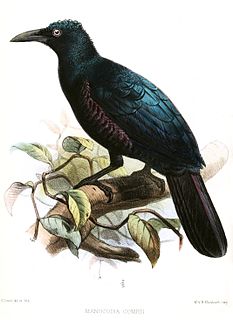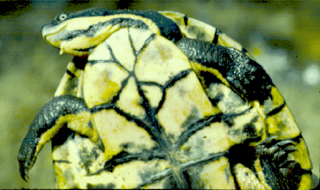Genus /ˈdʒiː.nəs/ is a taxonomic rank used in the biological classification of living and fossil organisms as well as viruses. In the hierarchy of biological classification, genus comes above species and below family. In binomial nomenclature, the genus name forms the first part of the binomial species name for each species within the genus.

Vespertilionidae is a family of microbats, of the order Chiroptera, flying, insect-eating mammals variously described as the common, vesper, or simple nosed bats. The vespertilionid family is the most diverse and widely distributed of bat families, specialised in many forms to occupy a range of habitats and ecological circumstances, and it is frequently observed or the subject of research. The facial features of the species are often simple, as they mainly rely on vocally emitted echolocation. The tails of the species are enclosed by the lower flight membranes between the legs. Over 300 species are distributed all over the world, on every continent except Antarctica. It owes its name to the genus Vespertilio, which takes its name from a word for bat, vespertilio, derived from the Latin term vesper meaning 'evening'; they are termed "evening bats" and were once referred to as "evening birds".

The Accipitridae, one of the three families within the order Accipitriformes, are a family of small to large birds with strongly hooked bills and variable morphology based on diet. They feed on a range of prey items from insects to medium-sized mammals, with a number feeding on carrion and a few feeding on fruit. The Accipitridae have a cosmopolitan distribution, being found on all the world's continents and a number of oceanic island groups. Some species are migratory.

Bufo is a genus of true toads in the amphibian family Bufonidae. As traditionally defined, it was a wastebasket genus containing a large number of toads from much of the world, but following taxonomic reviews most of these have been moved to other genera, leaving only seventeen extant (living) species from Europe, northern Africa and Asia in this genus, including the well-known common toad. Some of the genera that contain species formerly placed in Bufo are Anaxyrus, Bufotes, Duttaphrynus, Epidalea and Rhinella.

Laridae is a family of seabirds in the order Charadriiformes that includes the gulls, terns and skimmers. It includes around 100 species arranged into 22 genera. They are an adaptable group of mostly aerial birds found worldwide.

Chevrotains, or mouse-deer, are small even-toed ungulates that make up the family Tragulidae, the only extant members of the infraorder Tragulina. The 10 extant species are placed in three genera, but several species also are known only from fossils. The extant species are found in forests in South and Southeast Asia, with a single species, the water chevrotain, in the rainforests of Central and West Africa. They are solitary or live in pairs, and feed almost exclusively on plant material. Chevrotains are the smallest hoofed mammals in the world. The Asian species weigh between 0.7 and 8.0 kg, while the African chevrotain is considerably larger at 7–16 kg (15–35 lb). With an average length of 45 cm (18 in) and an average height of 30 cm (12 in), the Java mouse-deer is the smallest extant (living) ungulate or hoofed mammal, as well as the smallest extant even-toed ungulate.

Chelidae is one of three living families of the turtle/tortoise suborder Pleurodira, and are commonly called Austro-South American side-neck turtles. The family is distributed in Australia, New Guinea, parts of Indonesia, and throughout most of South America. It is a large family of turtles with a significant fossil history dating back to the Cretaceous. The family is entirely Gondwanan in origin, with no members found outside Gondwana, either in the present day or as a fossil.

The family Talpidae includes the moles, shrew moles, desmans, and other intermediate forms of small insectivorous mammals of the order Eulipotyphla. Talpids are all digging animals to various degrees: moles are completely subterranean animals; shrew moles and shrew-like moles somewhat less so; and desmans, while basically aquatic, excavate dry sleeping chambers; whilst the quite unique star-nosed mole is equally adept in the water and underground. Talpids are found across the Northern Hemisphere and southern Asia, Europe, and North America, although none are found in Ireland nor in the Americas south of northern Mexico.

The guenons are Old World monkeys of the genus Cercopithecus. Not all members of this genus have the word "guenon" in their common names; also, because of changes in scientific classification, some monkeys in other genera may have common names that include the word "guenon". Nonetheless, the use of the term guenon for monkeys of this genus is widely accepted.

The kipunji, also known as the highland mangabey, is a species of Old World monkey that lives in the highland forests of Tanzania. The kipunji has a unique call, described as a 'honk-bark', which distinguishes it from its relatives, the grey-cheeked mangabey and the black crested mangabey, whose calls are described as 'whoop-gobbles'.

Tapejara is a genus of Brazilian pterosaur from the Cretaceous Period. Tapejara crests consisted of a semicircular crest over the snout, and a bony prong which extended back behind the head.

Manucodes are birds-of-paradise in the genus Manucodia, that are medium-sized with black-glossed purple and green plumages.

Linnaea is a plant genus in the honeysuckle family Caprifoliaceae. Until 2013, the genus included a single species, Linnaea borealis. In 2013, on the basis of molecular phylogenetic evidence, the genus was expanded to include species formerly placed in Abelia, Diabelia, Dipelta, Kolkwitzia and Vesalea. However, this is rejected by the majority of subsequent scientific literature and flora.
Oligoryzomys moojeni is a species of rodent from South America in the genus Oligoryzomys of family Cricetidae. It is known only from central Brazil, where it is found in the cerrado and gallery forests. It is named after twentieth-century Brazilian zoologist João Moojen. Its karyotype has 2n = 70 and FNa = 84.

The Myuchelys is a genus of turtles, the Australian saw-shelled turtles, in the family Chelidae and subfamily Chelodininae. They inhabit the headwaters and tributaries of rivers within their range and this led to the name Myuchelys, which is formed from the Aboriginal word myuna meaning clear water and the Greek chelys meaning turtle. They have a short neck and the intergular scute completely separates the gular scutes. They have no alveolar ridge separating them from the snapping turtles of the genus Elseya.

Symposiachrus is a genus of birds in the family Monarchidae. Most species are endemic to islands in Melanesia but the spectacled monarch is widely distributed and occurs in parts of Indonesia and western Australia. The genus was previously lumped together in the genus Monarcha.
The Nemacheilidae, or stone loaches, are a family of cypriniform fishes that inhabit stream environments, mostly in Eurasia, with one genus, Afronemacheilus found in Africa. The family includes about 630 species.
Verongula rigida is a sponge species in the class Demospongiae. The scientific name of the species was first validly published in 1794 by Eugenius Johann Christoph Esper, as Spongia rigida.

Lupulella is a genus of canine found in Africa. This genus consists of only two extant species, the black-backed jackal and the side-striped jackal.















